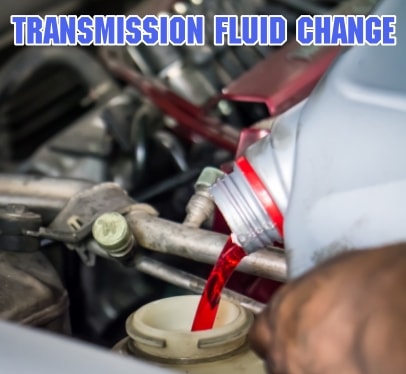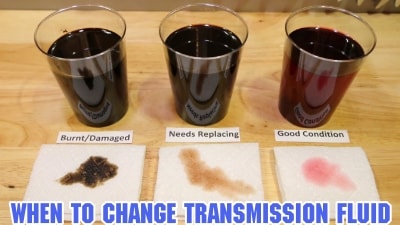The transmission fluid in the car performs two distinct functions. It lubricates and cleans up the engine. As the fluid moves around various parts, it will gobble up the dirt and all the metal shavings that have accumulated over time due to normal wear and tear. In some rare cases, the debris may settle at the bottom of the pan or housing. This means that it won’t make its way to the circulation system which is a very good thing.
But even then, the debris still needs to be removed. This is why you will see special machines in auto shops that can do a quick transmission fluid flush. This ensures that all the debris regardless of where it’s located is removed before new transmission oils are added into the car. Here you can find the average transmission fluid change cost for automatic transmissions flush at leading auto service centers like Walmart, Midas, NAPA…
Transmission Fluid Change Interval
Regular fluid changes will significantly extend the life of the car. For automatic transmissions, it’s recommended that the fluid is replaced every 30,000 miles.
How Much Does a Transmission Flush Cost?
Transmission fluid is responsible for lubricating the transmission system of your car, which in turn helps to prevent any damage associated with the system’s dehydration. It’s important to note that there are different transmission systems out there, hence the need for different transmission fluid products, and that ultimately determines the transmission service cost that you pay for changing the transmission fluid.
Now, for most cars, the average cost of transmission flush is usually between $120 and $450, depending on labor costs and how much is the transmission fluid that’s required, among other things.
Average Transmission Fluid Flush Cost Comparison
As you can see in the table below, where you have your transmission fluid changed can also have an impact on the overall amount that you pay. That and the warranty are important considerations to make when choosing a mechanic to do the job.
Transmission Fluid Change Cost
What’s a Transmission Fluid Change?
Transmission fluid is there to keep your car’s transmission system well lubricated, especially the moving parts. Transmission fluid also plays the role of the coolant fluid in automatic transmissions, which enables the system to transfer power from the engine more competently.
 Now, different vehicles use different types of transmission, hence the slightly wide variety in transmission fluids. For example, you’re most likely to use normal motor oil or particular gear oil for manual transmission, whereas automatic transmission fluid is more suited to automatic transmissions, as the name implies. Of course, each specific vehicle model has its own transmission fluid needs, which is why it’s always a good idea to check your car’s manufacturer specifications on the subject to be sure.
Now, different vehicles use different types of transmission, hence the slightly wide variety in transmission fluids. For example, you’re most likely to use normal motor oil or particular gear oil for manual transmission, whereas automatic transmission fluid is more suited to automatic transmissions, as the name implies. Of course, each specific vehicle model has its own transmission fluid needs, which is why it’s always a good idea to check your car’s manufacturer specifications on the subject to be sure.
Transmission oil change refers to replacing the old fluid in your car’s transmission system with new fluid. Over time, transmission system fluid gets polluted due to dust and debris falling into it, as well as the natural wear and tear of the parts that it’s supposed to be lubricating. As a result, the contaminated oil is no longer able to lubricate these different parts as it once did, and this could significantly compromise the function and lifespan of the overall transmission system.
The extra heat caused by the manual transmission can also accelerate degradation considerably. That said, automatic transmission system parts are not exempt from this type of degradation, which means that the transmission fluid is contaminated in just the same way. That’s why it’s so important that you replace the transmission fluid on a regular basis in order to avoid the accelerated degradation of the system over time.
Are Transmission Flushes Really Necessary?
Not only will regularly changing the transmission fluid help to maintain the proper function of the transmission system, but it will also lengthen the lifespan of the different parts thereof. The best part is that it will also help you avoid transmission system damage, thus saving you a ton in repair costs.
Any repairs or replacements associated with a transmission system are bound to cost you a small fortune, so it’s better to prevent either scenario from happening by keeping the system well-oiled and functioning as efficiently as possible.
Ideally, you want to check on your transmission fluid often by performing the ‘dipstick’ test at least once per month. If the stick comes out a red color, then the fluid is still good to go, but if the stick comes out a darker color or if there’s a slight burnt smell, then it’s time to replace the fluid. You should also change the transmission fluid if levels appear to be low.
When To Change Transmission Fluid?
If you ask different mechanics they will give you different opinions as to when the transmission oil needs to be changed. A number of car makers recommend that transmission fluids should be changed every 100,000 miles and some even 150,000. When you really think about it, this is far too long. On average, drivers will log between 12,000 and 15,000 miles a year. So, if you were to go with the manufacturer’s recommendation of changing the fluid after 100,000 miles or 150,000, you’d probably change the oil after 6.5 or 8.5 years. That’s just too long!
 The best solution is to have the fluid changed every 30,000 or 60,000 miles. Once every 2 to 4 years should also work. This is an optimal schedule for an average driver and it will go a long way in making sure that your transmission is running on healthy fluid. There’s no harm in replacing your fluid on a more regular basis but we think that every 30,000 to 60,000 miles will offer optimal results and save you a lot of money.
The best solution is to have the fluid changed every 30,000 or 60,000 miles. Once every 2 to 4 years should also work. This is an optimal schedule for an average driver and it will go a long way in making sure that your transmission is running on healthy fluid. There’s no harm in replacing your fluid on a more regular basis but we think that every 30,000 to 60,000 miles will offer optimal results and save you a lot of money.
Nonetheless, there are some unique situations that could demand fluid change sooner. These situations are often determined by your driving habits and other factors. For instance, for people who live in hotter climates and do a lot of towing, stop-and-go, heavy mauling, and even snow plowing on regular basis, the transmission fluid must be replaced sooner than the recommended timeframe. In these situations, the operating temperature of the fluid will be higher than normal. This will increase the rate of degradation significantly.
What’s Normally Done When Changing Fluid Transmission?
- Pay Your Car On-Ramps
The first step is putting your car up on-ramps. You can also jack up the front part of the vehicle too. Ensure that blocks are put in place on the back wheels. This will ensure the car remains in place. The process is often very messy so you may want to put on some protective gear. Old clothes that you don’t use should do. Dress up your work area with some newspapers to ensure the floor is not stained. You will also be required to dispose of the old oil appropriately. Some auto shops will have a place where you can dump the oil. The mechanics will also give you some ideas on how to dispose of the oil.
- Find the Transmission Pan
Once the car is set on ramps it’s time to locate the transmission pan. The car’s owner manual will have a guide on how to do this. Put the oil pan that you intend to use underneath the one already installed in the car. Remove the bolts carefully. Make sure your face is out of the way. The seal will be broken as the bolts get loose and the fluid will start to drip. Remove the bolts completely and let the oil drain until it’s done.
Once the fluid has fully dripped out, inspect the kind of debris it has. This can help you know whether the transmission is working well or not. The fluid should have no debris if your car is new. In some cases, you may find a small trace of aluminum on the fluid. This is normal. However, the more dirt you find on the fluid the higher the chances the gearbox is not working as required.
- Check the Gasket
Inspect the gasket to see if it needs to be replaced or not. If the gasket is completely worn out, you may need to replace it and you will save yourself a lot of future repair costs.
- Remove the Filter
Remove the filter only when the oil has drained completely. The filter has fluids in it too so be careful when you remove it. Once the filter is out, replace it with the new one and tighten the bolts. Go ahead and replace the bolts on the pan. Use your hands to tighten them first before going for a tool. As soon as the pan is in place, add the new oil. You should use a filter to avoid spillage.
Now start the car and let it run for a few minutes. Shift the gears a few times and then park it. Finally, check the dipstick. Just pull it out, wipe it, reinsert, and then remove it again. The oil should be sitting on the correct line. Bring the car down from the ramps and you are good to go.
How to Cut Transmission Fluid Change Cost
The best way to save money on a transmission fluid change is to do it yourself. A car owner with the right tools can easily do their own transmission fluid change, especially since the process is straightforward and doesn’t require the use of any specialist equipment. All you need to know is how much transmission fluid is required and you’re good to go.
Just make sure to recycle the used transmission fluid appropriately through local drop-off facilities, which you can access through your local mechanic or auto repair shop.
Alternatively, you can search for different service providers online and compare prices between them to find the best one. For best results on your search, simply input relevant keywords like “how much does it cost to change transmission fluid”, “transmission flush price”, “transmission flush cost near me”, “how much is a transmission flush” or “how much does a transmission flush cost”.
In this guide you will find:
